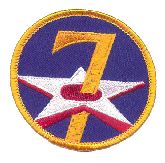
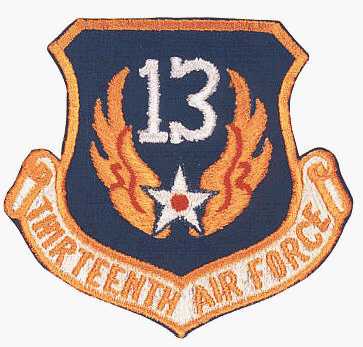
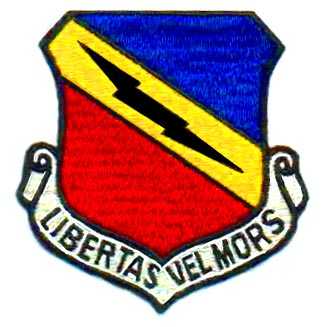
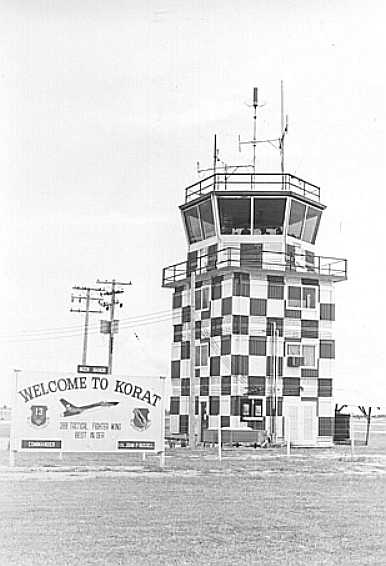
Col. John Russell - Commander
The USAF BASES in THAILAND
The illustration below shows the location of the various Royal Thai Air Force bases utilized throughout Thailand during the war.
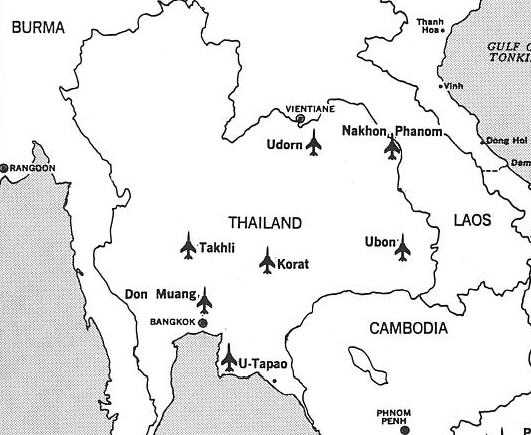
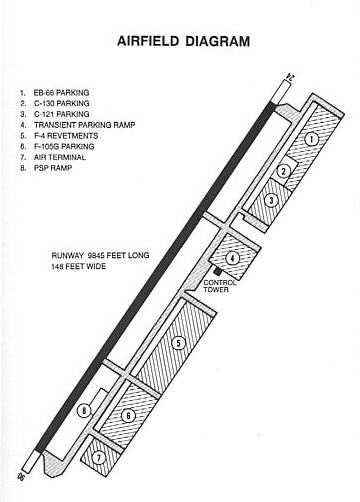
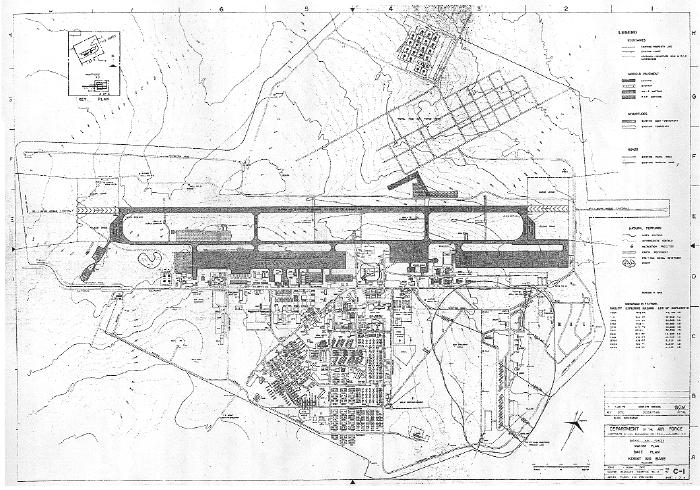
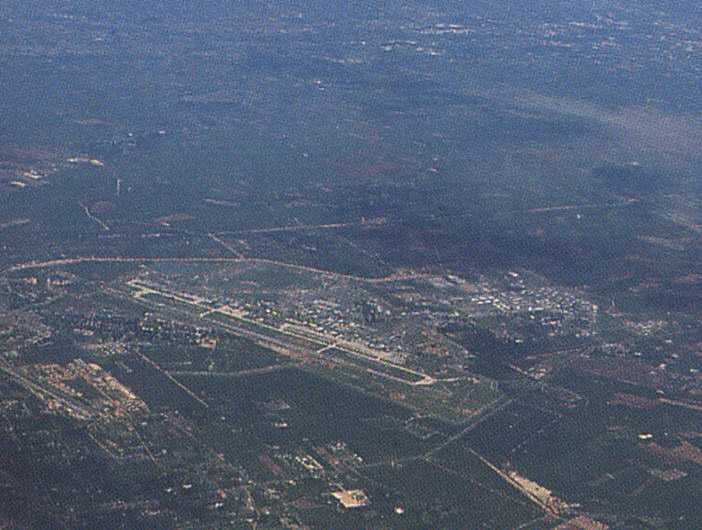
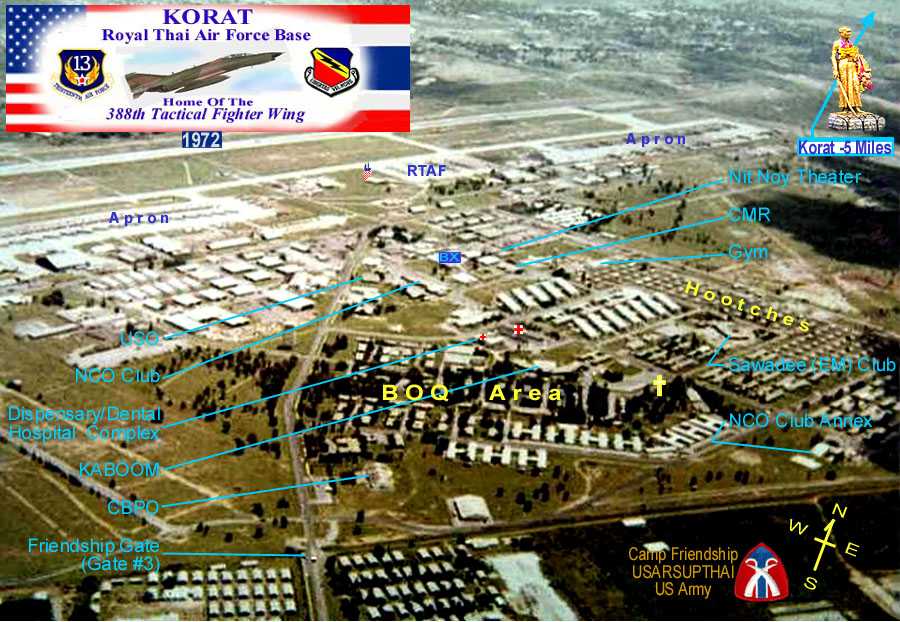
Topographic map of Korat RTAFB - 1972/3 revision
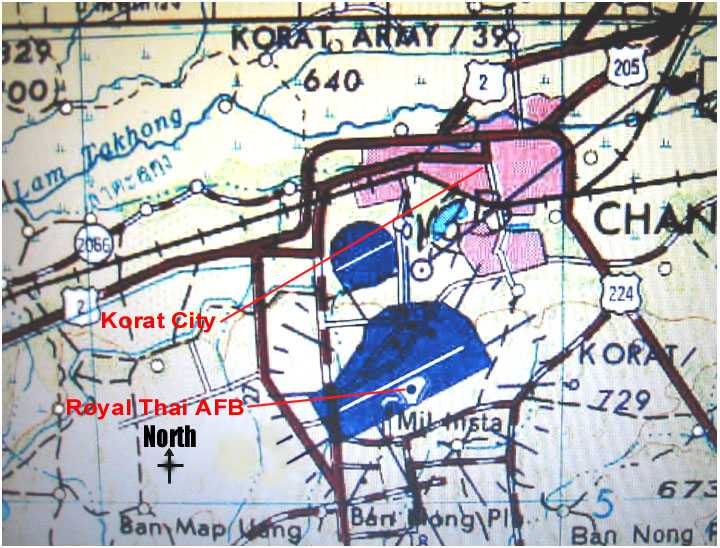
From a document called:
Fact Sheets and Histories of the United States Air Force at
Royal Thai Air Force Bases, dated 12 August 1972, and published
by the 13th Air Force Office of History.
FACT SHEET - KORAT ROYAL THAI AIRBASE
The primary mission of USAF units at Korat Royal Thai Air Force Base
is to conduct operations in support of U.S. commitments in Southeast
Asia. The base is the home of the 388th Tactical Fighter Wing which
is equipped with F-4E, F-105, RB-66 and C-130 aircraft. Other primary
aircraft are the EC-121s of the College Eye Task. Force, 552nd
Airborne Early Warning and Control Wing, and HC-130s and HH-43s of
Detachment 4, 3rd Aerospace Rescue and Recovery Group.
The Royal Thai Air Force 3rd Wing is the host unit at Korat, flying
the UH-1H and H-34 helicopters.
MAJOR UNITS: 388th Tactical Fighter Wing
388th Combat Support Group
Det .4, 3rd ARRS
552nd Airborne Early Warning and Control Wing
Hq., American Forces Thailand Network
1998th Communications Squadron
483rd Electronics Installation Sq
Det 17, 601st. Photo Flight
AIRCRAFT ASSIGNED: F-4E. F-105, EB-66, C-130, HC-130, HH-43, EC-121.
PERSONNEL STRENGTH: 4,500 U.S. military
HOSPITAL FACILITIES: 15 bed dispensary
RUNWAY LENGTH: 9,840 feet
MILES FROM BANGKOK: 165 miles northeast of Bangkok
<<<<<<<<<<<<<<<<<<<<<<<<<<<<<<<<<<<<>>>>>>>>>>>>>>>>>>>>>>>>>>>>>>>>>>>>
HISTORY OF THE UNITED STATES AIR FORCE
AT KORAT ROYAL THAI AIR FORCE BASE
<<<<<<<<<<<<<<<<<<<<<<<<<<<<<<<<<<<<>>>>>>>>>>>>>>>>>>>>>>>>>>>>>>>>>>>>
Currently hosting 30 units and agencies of six major USAF commands Korat
Royal Thai Air Force Base has come a long way since April 1962. At that
time, one officer and 14 airmen were temporarily assigned to the base as
the joint U.S. Military Advisory Group (JUSMAG).
In July, 1964, approximately 500 persons were assigned to Korat to start
the beginning of a tactical fighter operation. The operational mission
commenced 15 August 1964; and by October of the same year, essential USAF
base facilities were completed.
By late February 1965, the tactical fighter strength increased to two
squadrons flying the Republic F-105 "Thunderchiefs", both assigned to the
Pacific Air Forces. A Tactical Air Command McDonnell F-4C "Phantom"
rotational unit replaced one of the squadrons a month later.
USAF tactical operations in Thailand later came under the jurisdiction
of the 6234th Tactical Fighter Wing activated at Korat. For a year, the
wing and its subordinate units operating F-105s and F-4Cs flew 10,797
sorties totaling 26,165 hours. The wing's efforts merited the Presidential
Unit Citation in March 1968.
In April 1966, the 388th Tactical Fighter Wing was reactivated.
Historically known for its B-17 Flying Fortress operation in Europe
during World War II, the wing absorbed personnel and resources of the
6234th. The 388th TFW utilized three F-105 Thunderchief squadrons. These
initially were the 13th TFS., 421st TFS and the 469th TFS.
Prior to the bombing halt 1 November 1968, tactical fighter squadrons
assigned to the 388th contributed to the air strikes over North Vietnam.
For three years, Thunderchiefs from Korat and its sister wing at Takhli
Royal Thai Air Force base carried more than 75 per cent of all ordnance
delivered north of the demilitarized zone.
Combat operations expanded at Korat in late 1967 with the arrival of
EC-121 "Constellations" of the 553rd Reconnaissance Wing and Det 1, 552nd
Airborne Early Warning and Control Wing. The 553rd "Bat Cats" were a new
organization. They formed, trained, and deployed from Otis AFB, Mass.,
while Det 1, from McClellan AFB, Calif., had been in Southeast Asia since
April 1965. The EC-121s provided airborne radar coverage and surveillance
in support of aircraft flying combat operations. The 553rd was inactivated
in December 1979 while its subordinate unit, the 553rd Reconnaissance
Squadron continued operating out of. Korat for another year.
On 17 November 1968, an F-4E Phantom Squadron from Eglin AFB, Fla.,
replaced the F-105 Thunderchiefs of the 469th TFS. The new Phantom
squadron, the first E-models in Thailand, retained the designation 469th
TFS. All F-105s at Korat transferred to Takhli RTAFB in October 1969.
In November 1970, F-105s returned to Korat when the 6010th Wild Weasel
Squadron, flying specially equipped Thunderchiefs, was formed. It was
redesignated the 17th Wild Weasel Squadron on 1 December 1971 and today
is the only permanent F-105 unit in Southeast Asia.
Also in November 1970, the 42nd Tactical Electronic Warfare Squadron, which
flies EB-66s, transferred to Korat from Takhli. In April 1972, the 7th
Airborne Command and Control Squadron arrived from Udorn RTAFB and began
flying missions in its C-130 aircraft, which are equipped with command and
control capsules.
Today, the 388th Tactical Fighter Wing is composed of two F-4E squadrons,
one F-105 squadron, an EB-66 unit and the C-130 squadron.
(Dated 1972, because the F4-Es returned to the US and were replaced by the
A7-Ds. - Ed.)
After that, there were some additional units that served temporary duty status
at Korat:
35TFS, the F4-D's that came from DaNang...were from Kunsan Korea. Arrived
12 June 72 and went back to Korea Oct 72.
Korat RTAFB is located 5 miles south of Nakhon Ratchasima, Thailand (also known as Korat City). During the Vietnam War, the base served as home to many permanent and transient Air Force squadrons, as well as many other military and civilian forces. Primarily headquarters for the 3rd Helicopter Wing of the Royal Thai Air Force, the 388th Tactical Fighter Wing, and 553rd Reconnaissance Wing were chief among other commands that spent time stationed at Korat during the war. The 388th TFW was re-activated 14 March, 1966. It opened for business in April at Korat, taking over the complete assets of the 6234th TFW, which had been at Korat for a year. The Republic F-105 Thunderchief was the weapon of choice for the first few years, until the F4-E Phantom II aircraft arrived in Korat from the 33rd TFW, Eglin AFB, Florida in 1969. F-105G 2-seater Wild Weasel aircraft flew SAM suppression missions as their main focus for a number of years, staffed by a number of different Wings and Squadrons, such as 6010th WWS, 17th WWS, and Detachment A of the 561st TFS. Different tail codes marked these a/c over a short period of time: WW, ZB, MD, and JB. Other units and aircraft types also were major players at Korat.
The following list contains United States of America unit I.D., dates assigned to Korat RTAFB, and other appropriate info.
7th Airborne Command and Control Squadron: 4/15/1972 (388th Tactical Fighter Wing, 30 Apr 1972 (remained attached to Seventh Air Force to 15 Aug 1973)
12th Tactical Fighter Squadron, multiple deployments: 2/8/1965 - 3/15/1965; 6/15/1965 - 8/25/1965.
13th Tactical Fighter Squadron (attached to 388th Tactical Fighter Wing, 15 May 1966–17 Oct 1967 while under the 18th TFW).
34th Tactical Fighter Squadron "Rams": attached to the 388th TFW from 15 May 1966 to 15 March 1971 (operated from Takhli Feb 1969) while assigned to the 41st Air Division and later 347th TFW, Yokota, Japan). Assigned 388th TFW from 15 March 1971 to 23 Dec 1975. Flew the F-105 in combat from 1966 to 9 May 1969, and then the F-4 Phantom II. (JJ tail code).
35th Tactical Fighter Squadron "Black Panthers", deployed at Korat from Yokota AB, Japan, 24 Sep - 20 Nov 1964; Jun–c. 12 Oct 1972 while assigned to the 3d Tactical Fighter Wing, Kunsan AB, Republic of South Korea. (Flew the F-105 in combat in 1964 and the F-4 in 1972.)
36th Tactical Fighter Squadron "Flying Fiends", deployed at Korat from Yokota AB, Japan, 9 Aug - 5 Oct 1964. (Flew the F-105 in combat in 1964).
42nd Tactical Electronic Warfare Squadron (TEWS) flew variations of the Douglas B-66 Destroyer. The EB-66C and E (JW tail code) flew radar and communications jamming missions to disrupt enemy defenses and early warning capabilities.
44th Tactical Fighter Squadron, multiple deployments:12/18/1964 - 2/25/1965; 4/21/1965 - 6/22/1965; 10/19/1965 - 10/29/1965.
67th Tactical Fighter Squadron "Fighting Cocks" (1) with F-105s: 2/18/1965 - 4/26/1965; 8/16/1965 - 10/23/1965; (2) TDY 9/22/1972 – 2/19/1973 with six F-4C Wild Weasel aircraft and nine F-4C Wild Weasel aircrews.
68th Tactical Fighter Squadron "Lightning Lancers" : 27 Aug - 6 Dec, 1965 (while assigned to the 8th Tactical Fighter Wing, which was attached to the 6234th Tactical Fighter Wing).
80th Tactical Fighter Squadron "Headhunters": deployed at Korat from Yokota AB, Japan from 10/30/1964 - 12/29/1964. Flew the F-105 in combat in 1964.
357th Tactical Fighter Squadron "Dragons": 12 Jun. - 8 Nov 1965 (attached to the 6234th TFW).
421st Tactical Fighter Squadron flew the F-105 Thunderchief from April 1966 to April 24, 1967 under the 388th TFW.
A detachment of 552nd AEW&CW (Airborne Early Warning & Control Wing) EC-121 Lockheed L-1049 Super Constellations (call sign DISCO) flew Airborne Surveillance and Monitoring missions watching enemy aircraft movements and directing MiGCAP intercepts as part of the College Eye program.
Another group of Super Connies, known as "Bat Cats", EC-121Rs of the 553rd Reconnaissance Squadron flew as in Airborne Relay Stations "listening" to specialized sensors dropped along the Ho Chi Minh trail to detect the presence of troops, or vehicles utilizing state-of-the-art electronic technology.
During a period in 1972, some KC-135 Stratotankers were assigned to Korat to supplement Air Refueling operations during Linebacker I.
Per Larry Westin: There was another squadron TDY to Korat in 1970, the 193rd Tactical Warfare Squadron, Pennsylvania Air National Guard who flew the EC-121S. The USAF named the operation Task Force "Commando Buzz". More info can be found at Larry Westin's BatCat website. See Links page for current link.
Assorted C-130 aircraft were assigned to Korat for various amounts of time, depending on mission requirements.. Some elements of the 7th Airborne Command and Control Squadron, operated C-130E ABCCC aircraft. The 56th Air Rescue and Recovery Squadron operated HC-130P Search and Rescue (SAR) aircraft during most of 1972.
72 Corsair II A7-D aircraft of the 354th TFW from Myrtle Beach AFB, SC arrived in October 1972 to support elements of Constant Guard VI during the LINEBACKER campaigns. As well as supporting bombing missions originally supported by 2 squadrons of F4-Es, the A7's also provided "SANDY" close air support in relief of the A-1s from NKP.
Members of the 363 FMS of the 363 TRW (Shaw AFB) were TDY at Korat October 1972 through Feb of 1973 in support of Linebacker I.( Info supplied by Michael Guy - May 2007).
The 347th TFW - Black Knights - F-111's .
39th Aerospace Rescue and Recovery Squadron - Mar 72: 39 ARRS transferred to Korat RTAFB. 30 Apr 72: 39 ARRS inactivated. (undocumented)
The following list contains Allied Partners unit I.D., dates assigned to Korat RTAFB, and other appropriate info as received.
1962 - 1964, Royal New Zealand Air Force 41 Squadron had a detachment of two Bristol Freighters in Korat in response to a request to the NZ Government for a contribution to the program known as SLAT –Special Logistics Aid to Thailand. The detachment was to remain at Korat for more than two years on this project.

